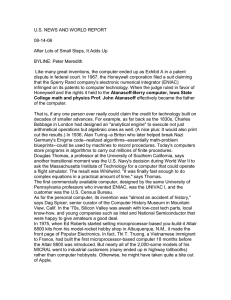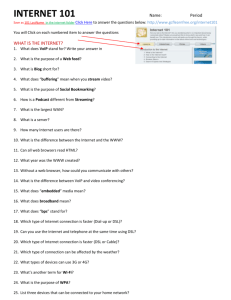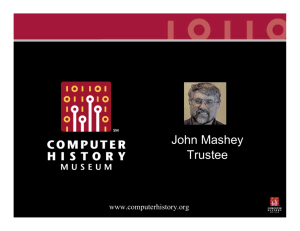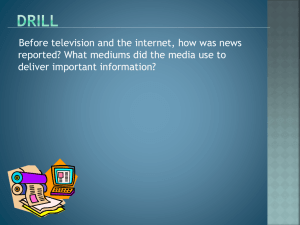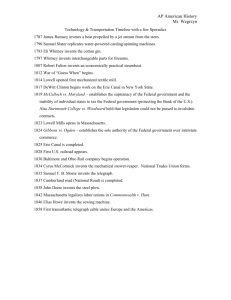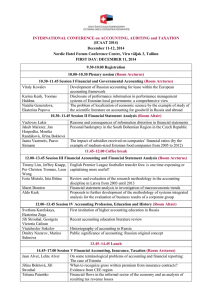History of Computers and the Internet
advertisement
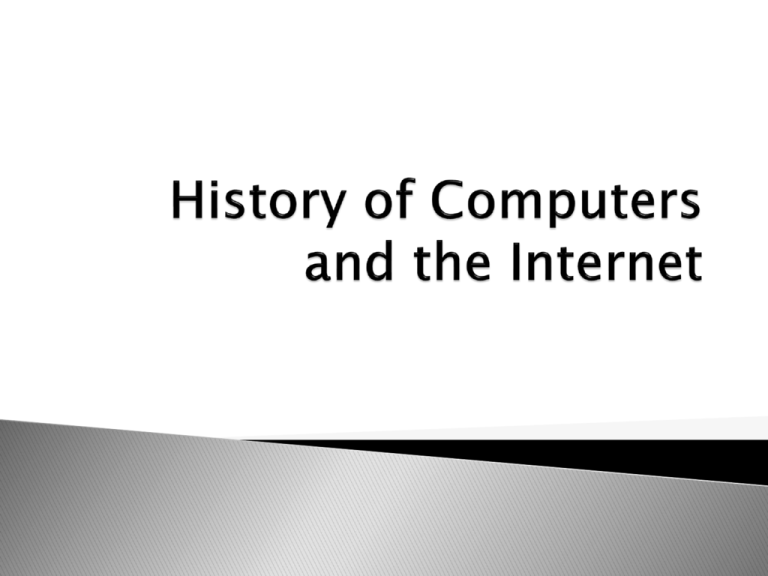
300 BC: Invention of the Abacus in Babylonia 1632: Wilhelm Schickard invents first mechanical calculator. Never used beyond prototype. 1801: Joseph-Marie Jacquard invents programmable loom. Works by reading punch cards. 1832: Charles Babbage begins work on the Analytical Engine. General use computer that used punch cards. 1941: Konrad Zuse develops first electronic general use calculator. 1943: British government completes Colossus, a code breaking computer. 1964: IBM unveils the IBM 360. Quickly becomes standard computer for institutions. 1968: Doug Engelbart develops a word processing application. 1975: MITS Altair 8800 is featured on Popular Mechanics cover as the 1st personal computer 1975: Bill Gates and Paul Allen write BASIC for Altair 8800. Represents beginning of Microsoft 1979: First spreadsheet program, Visical, is written. 1984: The Apple Macintosh is released. What is the Internet? ◦ Millions of interconnected computers ◦ A Network of Networks ◦ A user at any one computer, with permission, can have access to any other computer ◦ Networking 1st developed by the Advanced Research Projects Agency 1958: ARPA established 1963: Time Sharing was developed 1969: ARPANet goes online 1979: Colleges begin developing internets between other schools 1991: Tim Berners-Lee develops the WWW. 1993: WWW shows a more then 300,000% growth in traffic in one year. Dial-up provided by an ISP (Internet Service Provider) though a modem Satellite connections ◦ Generally used in areas w/o DSL DSL (Digital Subscriber Line) provides broadband connection ◦ (~70 times faster then Dial-up) Wireless Internet Connections (varies) The Internet Millions of computers Many networks (or smaller internets) Many varieties of languages used (protocols) The WWW Millions of computers Way of accessing information contained on the Internet Only uses HPPT protocol The World Wide Web utilizes Web Browsers (Internet Explorer, Firefox, etc.) to search web pages that are linked though hyperlinks. Web pages can contain graphics, sound, text and video WWW searched using Web Browsers ◦ ie: Internet Explorer, Firefox, Safari Three main ways ◦ Address Bar ◦ Hyperlinks ◦ Search Engines Unique address for website or webpage. Entered in the address bar of a window. Example: http://www.yahoo.com 1) http: = written in the Hypertext Transfer Protocol 2) www. = this site is located on the World Wide Web 3) 4) yahoo = this is the domain name (tells your computer which computer to request the file from) .com = extension (usually describes the type site) .com – used for most commercial sites .edu – designates an educational website .gov – a site operated by the government .org – a website created by an organization (usually not for profit) .net – a site found on a particular network Searching the Internet can become very frustrating. Here are some steps that may increase your effectiveness at searching the Internet 1) Work out exactly what you want to know Write down key words Think of synonyms you could also search for 2) Know your search engine of choice 3) Understand Boolean Basics (if used by your search engine) 4) Know how to evaluate an internet source Downloading: the transmission of a file on one computer to another computer Malware: (Malicious Software) any program, file, or code that performs malicious actions on the target system without the user’s express consent. - Use and Update Anti-Virus - Keep important info on a computer not connected to the internet, or on a computer that employees strong firewalls - Do NOT open unknown e-mail E-mail: about as privet as a postcard. Very little protection through the Law SPAM: unsolicited e-mail - prevent SPAM by deleting messages from unknown people - do not give out e-mail on internet forms - if receive messages from, asked to betaken off mailing list http://www.onguardonline.gov/default.aspx# 1) 2) 3) 4) 5) Spyware/Adware- place tracking cookies on your computer that track surfing habits Keylogger- programs that track every key stroke that is made on a certain computer Trojan Horse- appears to be a beneficial program, but once installed begins infecting other files. May also install a backdoor. Virus- is attached to another legitimate program. As that program runs, so does the virus. Worms- self-replicating program then sending copies of itself to other computers on the network without human intervention. Your computer starts running sluggishly. It shuts down unexpectedly or crashes frequently. It experiences memory problems or runs out of disc space. Unusual files or directories appear on your system. Strange messages appear on your screen. • • • • • • http://www.pbs.org/nerds/timeline/network.html -brief description on development of the computer and internet http://www.history.com/encyclopedia.do?articleId=212808 – History Channel; excellent overview the history of the internet http://www.computerhistory.org/timeline/?category=cmptr – Year by Year overview of the development of the computer http://www.computerhistory.org/internet_history/ -Year by Year overview of the development of the internet http://www.crunchers.bc.ca/library/history.html -History of the development of the internet; written in very simple layman’s terms http://www.cnri.reston.va.us/what_is_internet.html -government developed document describing the development of the internet. Uses some complex language.
